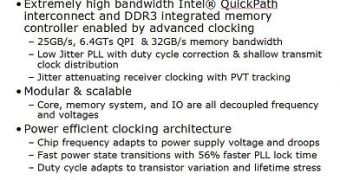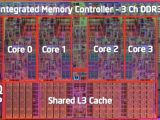Intel decided it was time to release a few more details on its ready-to-come Nehalem chip, as the release date is approaching and we are all dying to take at least glimpses at the next-generation processors. Intel will reveal some details on the chips in a paper due on Tuesday.
Rajesh Kumar, Intel fellow and director of the Circuit & Low Power Technologies Digital Enterprise Group, said a few words about the details to be revealed in the paper, and also gave some info on the power savings and on few major data transfer goals of the future Nehalem. Users will be able to enjoy Intel's next-generation chip architecture starting with the fourth quarter of this year. One of the major new features Nehalem will bring is QuickPath, a data transfer technology.
"Starting in 2008 with its next generation microarchitectures - code named Nehalem and Tukwila - Intel is incorporating a scalable shared memory (also known as non-uniform shared access or NUMA). Intel's new system architecture and platform technology will be called Intel QuickPath Technology. It features new system architecture that: 1) integrates a memory controller into each microprocessor, and 2) connects processors and other components with a new high-speed interconnect. Previously announced under the code name Common System Interface or CSI, the Intel QuickPath Interconnect is designed to unleash the performance of Intel's future generations of multi-core processors, delivering the additional performance, bandwidth, and reliability required to support Intel's next generation of dynamically scalable processors and platforms," Intel QuickPath Architecture White Paper states (PDF).
Rajesh Kumar explained why there are more components integrated into the new Nehalem, including the memory controller, in comparison to Intel's old chips. "The reason we are doing this is to get lower latency to memory. And much higher bandwidth to memory," he added. According to him, Nehalem will be able to provide "25 gigabytes per second for socket to socket (chip to chip) communication. And 32 gigabytes per second going to main memory".
"We're about 3X faster than our competition today"
"The number of cores and most of its features are modular. You can change the number of cores in different segments, for example. But just doing that is not sufficient. Because we're going to emphasize energy efficiency for some cases and high performance for others, we also needed to makes these things scalable," Kumar said on describing Intel's efforts to provide more optimization for power saving that it has done with its previous generations of processors.
Kumar also explained the way processors can be scaled for different markets. According to him, Intel has designed all the main components to work each on its own personal manner. This way, frequency and voltage can be set independently from other parts. While the CPU core runs at its specific frequency and voltage, the memory system runs at its own, and the same happens with the I/O (Input/Output). Each of these parts can be tuned to fit a given market segment.
Kumar also stated that this is not a new technology in itself. The technique used by Intel is different from its competitors. "The idea itself is not new but the implementation is new. So far, most people that have tried this idea have done this using what are called asynchronous interfaces which happen to be fairly slow. So the main idea is how to do all of this in a synchronous fashion with very low latency and high performance".
He also said a few words on the way Nehalem chips feature better tuning for operating on the power level that is delivered to them. "Chips today run at a given frequency, at a given voltage. But we know that when running different applications the power supply keeps moving around (?).What we have introduced is a chip whose frequency keeps adapting every cycle to the dynamic and real time power supply it actually sees."
Another related news shows some info on three versions of the Nehalem processor. The three Bloomfield will feature 3.2GHz, 2.93GHz, and 2.66GHz, respectively. They feature four processing cores able to run eight threads, have 8MB of level-3 cache memory, as well as a thermal envelope of 130 watts.

 14 DAY TRIAL //
14 DAY TRIAL // 
